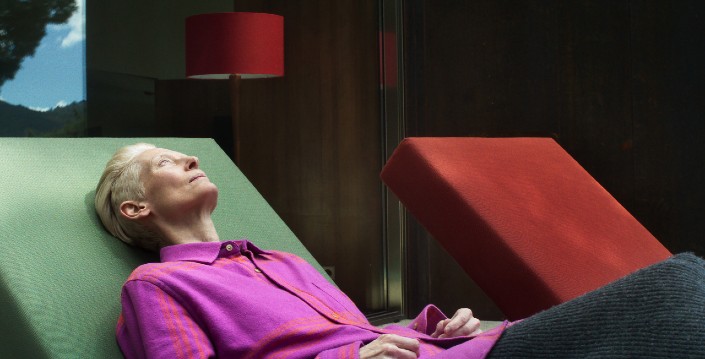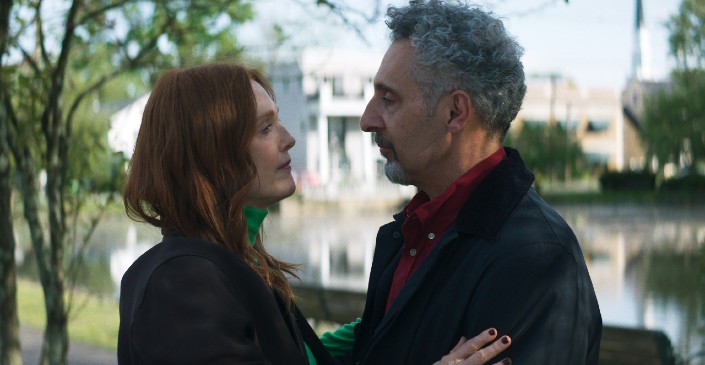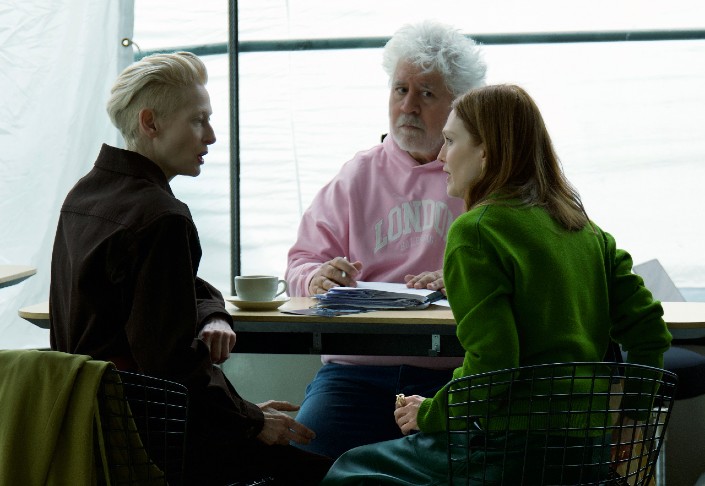Ingrid (Julianne Moore) and Martha (Tilda Swinton) were close friends in their youth, when they worked together at the same magazine. Ingrid went on to become an autofiction novelist while Martha became a war reporter. Eventually, they were separated by the circumstances of life.
When Ingrid finds out Martha has terminal cancer, she visits her and thus the rekindling of this old friendship begins. As the two women reconnect, they reminisce about their younger selves, their past loves, their fears and their hopes.
As her cancer progresses, Martha decides she will end her life on her terms. She no longer wants cancer treatments and has obtained a means to end her life in a painless way. As Martha ponders on her life’s inevitable end, we learn her connection to her daughter has been fractured for years, and has no one else to lean on but Ingrid during this time. Ingrid is hesitant to be part of Martha’s plan, but with time, she agrees to go to a House in the Woods with Martha to live out her last days.

Ingrid wrestles with her fear of death and dying through this time. She reconnects with a mutual friend/lover of hers and Martha’s, Damian Cunningham – played by the always charming John Turturro. He becomes sort of a voice of reason and soundboard to Ingrid. Unsurprised by Martha’s decision to end her life ‘on her terms’, he advises Ingrid to seek legal counsel since in the USA euthanasia is still frowned upon and is condemned by religious fanatics who see it as a sin and ‘a crime’. Damian has a great line about the state of healthcare in the USA and how euthanasia will not be accepted until the healthcare system collapses on itself.
Written and directed by Pedro Almodóvar, The Room Next Door is his English-language film. As it is expected of all his films, there is a lot of talking in this film. The film has a melodrama feel in its language and in other narrative elements. Tilda Swinton speaks a lot and she delivers her lines as eloquently as ever, which are complimented nicely by Julianne Moore’s attentive nature. The two actresses are great to watch on screen. Their moments of laughter, sorrow, anger and tenderness pull us into the story.

Elements that complement the feel quite well are the use of literary, art and film references throughout. Film references include the likes of Buster Keaton (Seven Chances), John Huston (The Dead), Max Ophüls (Letter from an Unknown Woman). The film includes several literary references, including James Joyce’s The Dead and Virginia Woolf’s A Room of One’s Own. Almodóvar, being a lover of colour, also includes visual art references like that of Edward Hopper’s work – production designer Inbal Weinberg utilizes Hopper’s colours as reference throughout the film. It is also evident director of photography Eduard Grau also uses Hopper as an inspiration in lighting and in composition.
On an emotional level, the film works for me in how it emphasizes the importance of ‘being there’ with someone we care about. Being there during difficult times in a supportive manner is essentially what we all hope to give and receive. What the two actresses achieve here are those moments of ‘being there’ with one another. We do not always have to speak; we can be there by actively listening, as Almodóvar puts it, “so the other person speaking sees their words reflected in the eyes of the one listening and accompanying them.” My favourite scenes in the film are the quiet moments, be it when Martha and Ingrid are alone with their own thoughts, or when they are together in silence, holding space.

The Room Next Door is based on Sigrid Nunez’s 2020 novel What Are You Going Through, a story about assisted dying. From my understanding Almodóvar’s film is more of an improvisation on the novel.
Although the film’s topic might come across as bleak for some, The Room Next Door is still very much an Almodóvar film. It talks about a friendship rekindled by the two main female characters, which becomes a relationship similar to romantic love, but without love’s inconveniences. The film also leaves us with thoughts about death and dying – dying with dignity and being able to have control of our own life until the end.
Images courtesy of Sony Pictures Classics.






